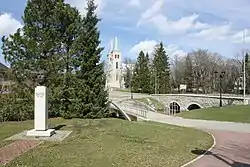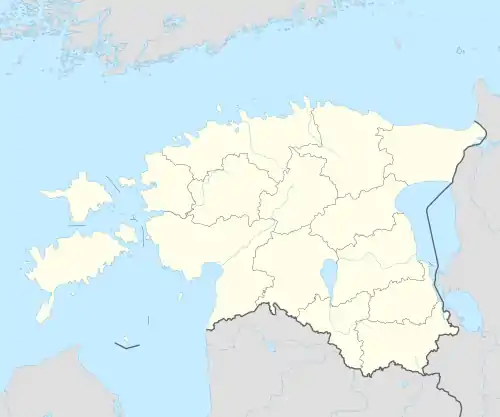Rapla
Rapla (German: Rappel) is a town in central Estonia, the capital of Rapla County and the centre of Rapla Parish. The oldest records date back to 1241 in the Danish Census Book, when it was said that it was a small village with 8 acres of cultivated fields. By the end of the 13th century, the village centre was firmly established. At around the same time, a Cistercian monastery was built.
Rapla | |
|---|---|
 Bridges over Vigala River. Rapla church in the background and monument to Brigadier General Märt Tiru on right. | |
 Rapla Location in Estonia | |
| Coordinates: 58°59′40″N 24°48′04″E | |
| Country | |
| County | |
| Municipality | |
| Elevation | 67 m (220 ft) |
| Population (2018)[1] | |
| • Total | 5,132 |
| • Rank | 22nd |
| Time zone | UTC+2 (EET) |
| • Summer (DST) | UTC+3 (EEST) |
| Postal code | 79511 |
| Area code(s) | (+372) 048 |
| Vehicle registration | L |
Rapla's ambitious period of fast growth began only in the late 19th century. In 1866, a pharmacy was built, in 1868 a school, and in 1888 a hospital. In 1898, a Brick factory was opened, and in 1900, a railway line was built between Rapla and Viljandi. The old stone church was demolished in the late 19th century and a new one was built in a Romanesque style, one of the purest examples of this style in all of Estonia.
In 1913, Rapla consisted of around 20 stone and 60 wooden houses. During this time period, a number of social societies were established, such as the Volunteer Fire Company, the Song and Music Society, the Society of Agriculture, a Mutual Fire Insurance Company, a Consumer Association, and the Deposit Insurance Fund.
It has a railway station on the Tallinn–Viljandi railway line operated by Elron. In 1931, a narrow gauge railway from Rapla to Virtsu opened and remained in use until 1968.
Gallery
 Rapla Maria Magdalena Lutheran Church
Rapla Maria Magdalena Lutheran Church Rapla railway station
Rapla railway station Rapla cultural centre
Rapla cultural centre Central square of Rapla
Central square of Rapla.jpg.webp) Bank in Rapla
Bank in Rapla
See also
- Cheleutochroa (Acritarch from the Rapla borehole)

